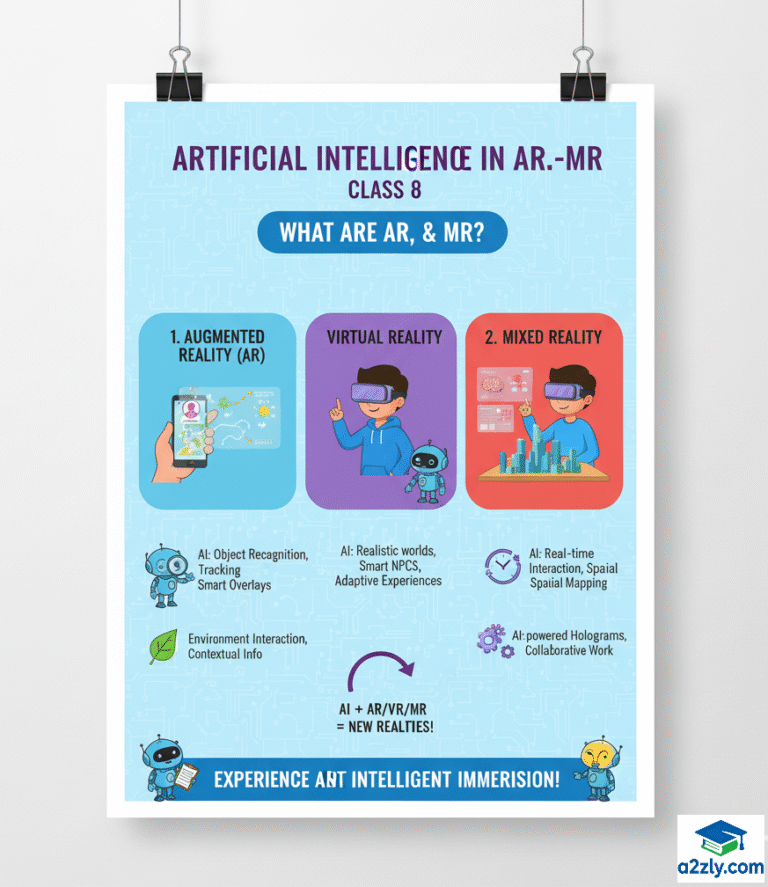🧭 Chapter Overview
Artificial Intelligence (AI) works hand-in-hand with immersive technologies like AR (Augmented Reality), VR (Virtual Reality), and MR (Mixed Reality).
Together, they create smart, interactive, and lifelike digital experiences — blending the real and virtual worlds.
3.1 Introduction to Augmented Reality (AR) and Virtual Reality (VR)
💡 Definition:
- AR (Augmented Reality) adds digital elements (like images, text, 3D models) to the real world.
- VR (Virtual Reality) creates a fully digital, computer-generated environment that users can explore.
AI makes both AR and VR intelligent by analyzing user behavior, recognizing objects, and adapting environments.
🧩 Example:
| Technology | Example Use |
|---|---|
| AR | Pokémon GO (adds Pokémon into real-world view) |
| VR | Oculus headset for 3D gaming or virtual tours |
🧠 Mind Map: Introduction
AI + AR–VR–MR
|
-------------------------
| | |
AR VR MR
(Adds to real) (Creates new) (Blends both)
3.2 What is AR (Augmented Reality)?
💡 Definition:
Augmented Reality (AR) overlays digital content (text, images, 3D models, sounds) onto the real-world view through devices like smartphones, AR glasses, or tablets.
📲 How It Works:
- Camera captures real-world scene.
- AI detects and understands objects.
- Digital elements are placed accordingly.
🧩 Example Applications:
- Snapchat filters 👓
- IKEA app (visualize furniture at home)
- Google Lens (identify objects through camera)
🧠 Mind Map: AR
Augmented Reality (AR)
|
-----------------------------
| | | |
Real World Digital AI Object User
View Overlay Detection Interaction
3.3 What is VR (Virtual Reality)?
💡 Definition:
Virtual Reality (VR) immerses the user in a completely artificial 3D environment, replacing the real world entirely.
⚙️ How It Works:
- Requires VR headset or goggles (e.g., Oculus, HTC Vive).
- Sensors track head and body movements.
- AI helps create intelligent virtual worlds and characters.
🧩 Example Applications:
- VR games 🎮
- Virtual museum tours 🏛️
- Flight simulator training ✈️
🧠 Mind Map: VR
Virtual Reality (VR)
|
----------------------------------
| | | |
3D World VR Headset Sensors AI Interactions
3.4 What is MR (Mixed Reality)?
💡 Definition:
Mixed Reality (MR) is the fusion of AR and VR, where digital and real-world elements interact with each other in real time.
🧩 Example:
- Microsoft HoloLens 🕶️ allows users to see and manipulate 3D holograms that appear in their surroundings.
🧠 Mind Map: MR
Mixed Reality (MR)
|
--------------------------------
| | |
Real + Virtual Interaction AI Tracking
Environment Between Both & Analysis
3.5 How AI is Used in AR and VR
AI makes AR and VR smarter by analyzing user actions, recognizing environments, and predicting what users need next.
3.5.1 AI in AR
| AI Function | Description | Example |
|---|---|---|
| Object Recognition | Identifies and labels real-world objects | Google Lens |
| Image Segmentation | Detects shapes and boundaries | Snapchat Filters |
| Real-Time Translation | Translates text seen through the camera | Google Translate App |
| Gesture Recognition | Understands user gestures | AR-based games |
3.5.2 AI in VR
| AI Function | Description | Example |
|---|---|---|
| NPC Behavior | AI controls characters in games | VR Role-playing games |
| Scene Understanding | Creates dynamic environments | AI-generated 3D worlds |
| Speech Recognition | Enables voice commands | Virtual assistants in VR |
| Emotion Detection | Adapts environment to user emotions | Meditation VR apps |
🧠 Mind Map: AI in AR–VR
AI in AR–VR
|
--------------------------
| |
AI in AR AI in VR
(Object Recognition) (NPCs, Voice, Emotions)
3.6 Application Areas of AI in AR and VR
3.6.1 Gaming
🎮 AI-driven AR/VR games offer:
- Realistic environments
- Smart opponents (AI bots)
- Personalized experiences
Example: Beat Saber, Pokémon GO, Half-Life: Alyx
3.6.2 Education
🎓 AI + AR/VR in education helps:
- Virtual classrooms
- 3D model visualization (Science, History)
- Personalized tutoring
Example: Virtual labs for chemistry experiments.
3.6.3 Healthcare
🏥 AI enhances medical AR/VR in:
- Surgical simulations
- Anatomy learning through 3D visuals
- Therapy and rehabilitation
Example: VR-based mental health therapy or surgery training apps.
🧠 Mind Map: Applications
AI in AR–VR: Applications
|
--------------------------------
| | |
Gaming Education Healthcare
3.7 VR vs AR vs MR
3.7.1 VR vs AR
| Feature | Virtual Reality (VR) | Augmented Reality (AR) |
|---|---|---|
| World | Fully virtual | Mix of real + digital |
| Device | VR Headset | Smartphone, AR glasses |
| Interaction | Inside a 3D world | Real-world with virtual elements |
| Example | VR Game | Pokémon GO |
3.7.2 AR vs MR
| Feature | Augmented Reality (AR) | Mixed Reality (MR) |
|---|---|---|
| Integration | Adds digital objects | Blends and interacts with real world |
| Interaction | Limited | Real-time interaction possible |
| Example | Snapchat filters | Microsoft HoloLens |
🧠 Mind Map: VR vs AR vs MR
Comparison: AR – VR – MR
|
----------------------------------------
| | |
AR VR MR
(Adds) (Replaces) (Blends & Interacts)
3.8 AI’s Role in Making AR and VR More Realistic
AI enhances immersion by making virtual and augmented environments more human-like and interactive.
3.8.1 AI-Generated Content
AI creates dynamic environments, textures, and objects automatically.
| Use | Description |
|---|---|
| Procedural Generation | AI builds endless game worlds |
| Realistic Avatars | AI creates 3D avatars resembling real people |
| Natural Conversations | Chatbots or NPCs talk realistically |
3.8.2 AI for Realistic Physics
AI simulates real-world physics such as:
- Object movement
- Light reflections
- Gravity and collisions
Example: When a player throws a ball in VR, AI ensures it moves like a real ball.
🧠 Mind Map: AI’s Role in Realism
AI’s Role in Realistic AR–VR
|
-----------------------------
| |
AI-Generated Content Realistic Physics
3.9 Advantages of AI in AR and VR
| Advantage | Description |
|---|---|
| 🎯 Realism | Creates lifelike, natural experiences |
| 🧠 Interactivity | AI responds to user behavior |
| 📈 Efficiency | Automates environment generation |
| 🎮 Engagement | Increases user excitement |
| 🎓 Learning Aid | Makes education more visual and fun |
🧠 Mind Map: Advantages
Advantages of AI in AR–VR
|
-------------------------------
| | | |
Realism Interactivity Efficiency Engagement
3.10 Future of AI in AR and VR
The combination of AI and immersive tech will reshape education, entertainment, work, and medicine.
🔮 Future Trends:
| Future Area | Description |
|---|---|
| 🧠 AI Personalization | AR/VR adjusts to user behavior and mood |
| 👩🏫 Education | Virtual AI teachers in immersive classrooms |
| 🏥 Medicine | Real-time patient diagnosis and surgery guidance |
| 🏙️ Smart Cities | AI-powered AR for navigation and design |
| 🌐 Metaverse | Fully AI-managed virtual worlds with real interaction |
🧠 Mind Map: Future of AI in AR–VR–MR
Future of AI in AR–VR–MR
|
------------------------------------
| | | |
Education Healthcare Metaverse Smart Cities
📘 Summary Table: Chapter 3 – AI in AR–VR–MR
| Section | Topic | Key Idea |
|---|---|---|
| 3.1 | Introduction | AR adds to real world; VR creates new one |
| 3.2 | What is AR | Digital overlay on real environment |
| 3.3 | What is VR | Fully immersive 3D experience |
| 3.4 | What is MR | Real and virtual worlds interact |
| 3.5 | AI in AR–VR | AI enables recognition, response, and realism |
| 3.6 | Applications | Gaming, Education, Healthcare |
| 3.7 | Comparison | AR vs VR vs MR differences |
| 3.8 | AI’s Role | AI adds realism, physics, and interactivity |
| 3.9 | Advantages | Realistic, interactive, and engaging |
| 3.10 | Future | Personalized, intelligent virtual worlds |
✅ Key Takeaways
- AR enhances reality, VR replaces it, and MR blends both.
- AI is the brain that powers these technologies, making them smart and adaptive.
- Used in education, healthcare, gaming, and training.
- Future AI–AR–VR integration will lead to realistic metaverse experiences and personalized learning environments.

